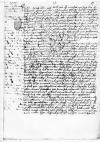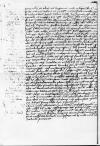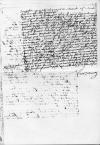List #5771
Ioannes DANTISCUS do [Alfonso] de VALDÉSValladolid, 1529-02-01
Regest polski: Dantyszek odpowiada na list Valdesa z 16 stycznia, przesłany mu wraz z całym plikiem listów od reszty przyjaciół [zachowane listy od Johanna Albrechta von Brandenburg-Ansbach, Maximiliaana van Egmond-Buren, Juana Antonio Marliano, Nicolasa Perrenot de Granvelle]. Przeczytał go kilkakrotnie z wielką radością. Cieszy się, że Valdes nie przywiązuje wagi do ceremonii. Komentuje opisaną mu przez Valdesa sprawę Lalemanda. Uważa, że byłoby bardzo niedobrze, gdyby uniknął on kary. Przesyła epicedium i epitafium, które napisał dla Lalemanda, nie żeby życzył mu śmierci, ale by spełnić prośbę przyjaciół. Obiecuje przesłać Pasquillus i inne [teksty], kiedy będzie opuszczał Hiszpanię, wszystko to jeszcze nie jest gotowe do druku. Chciałby, aby Valdes przesłał mu swój dialog, o którym w Valladolid krążą pogłoski, że jest autorstwa admirała [Kastylii, Fadrique Enríquez de Velasco]. Prosi również o łaciński utwór Valdesa o pojedynku — ceni w nim prawdę historyczną oraz ostatni akt, w którym występuje poseł cesarza do Francji. Dziwi się, dlaczego tekst nie został jeszcze wydrukowany, mimo że wszystko zostało dokładnie opisane po hiszpańsku. Nie wie, po co i jak ma go przejrzeć cesarz, chyba że przetłumaczy mu biskup Osmy [Juan García de Loaysa y Mendoza]. Przytacza anegdotę dotyczącą biskupa Osmy i jego kochanki Marii de la Torre. W czasach kiedy biskup Osmy był generałem zakonu [Dominikanów], kochanka ta żyła w klasztorze w opinii świętości, a kiedy zmarła, okazało się, że miała z generałem 2 synów. Dantyszek, ironizując, chwali biskupa Osmy za naturalne dążenie do zrodzenia potomstwa i za huczne wydanie kuzynki za mąż w Burgos. Uważa, że historie o biskupie Osmy doskonale nadają się do Pasquillusa. Dantyszek cieszy się z powrotu kanclerza [Mercurino Gattinary], bardziej by się jednak ucieszył z jego powrotu do zdrowia. Pisze do niego krótko, prosi Valdesa o ewentualne ustne uzupełnienie tego listu i o przekazanie kanclerzowi pozdrowień. Żartobliwie zarzuca Valdesowi, że rozbudził w nim ambicję — odsyła dokument nadania tytułu eques auratus do poprawienia, między innymi zależy mu na wprowadzeniu szczegółów dotyczących jego urodzenia, a zwłaszcza, aby podkreślono, że tytuł pochodzi raczej z dworu hiszpańskiego a nie cesarskiego, ponieważ tytuł hiszpański jest wyżej ceniony w jego ojczyźnie. Pozostawia Valdesowi wolną rękę co do redakcji poprawek. Prosi Valdesa o przekazywanie korespondencji za pośrednictwem Welserów, którzy pokryją wszelkie koszty, do Sarmacji zaś może posyłać listy także przez Fuggerów, adresując je do ich krakowskiego faktora Georga Hegla. Dantyszek prosi Valdesa o wystawienie nowego pisma, zwalniającego go ze służby na dworze cesarskim, mijają już bowiem 3 miesiące od daty poprzedniego, wystawionego, gdy wyjeżdżał z Toledo 17 grudnia [1528]. Dantyszek niepokoi się, że nie wrócił jeszcze sługa, którego 7 stycznia posłał po paszport dyplomatyczny do Bajonny. Nie wyjedzie z Valladolid, dopóki nie otrzyma odpowiedzi od Valdesa, chyba że zastanie go tam Wielki Post, wówczas poszuka miejsca bardziej obfitego w ryby. Powtarza za poprzednim swoim listem, że dziecinnieje, ponieważ nie cieszy go nic, prócz zajęć literackich. Prócz tego co niedziela słucha pobożnych i prawdziwie chrześcijańskich kazań benedyktyna Alfonsa de Virues. Nie zna go osobiście i pyta Valdesa, czy coś o nim wie. Nowiny w Valladolid dotyczą przede wszystkim planowanej podróży cesarza wraz z dworem do Italii, i tego że kwatermistrzowie zostali już posłani do Granady. Pisano mu też dzień wcześniej z dworu, że biskup Sewilli uwięził ciężarnego mnicha hermafrodytę, członka kapituły. Dantyszek uważa tę historię za godną opisania w Pasquillusie i prosi Valdesa o dalsze szczegóły, a także o inne nowiny, w tym dotyczące Lalemanda. Przekazuje pozdrowienia dla Giovanniego Bartholomeo i Hieronima Gattinary, Antoniego Longusa, brata Valdesa Diego, a także Marliano, którego Valdes ma upomnieć, by uwolnił Dantyszka od zobowiazań poręczyciela wobec jego rodziny (gentibus suis) w Valladolid. Suares’a ma Valdes pozdrowić tylekroć, ilekroć Lalemand będzie żałował kiedyś swoich uczynków. Isis [Isabel Delgada] wraz z cała rodziną przekazuje Valdesowi życzenia wszelkiej pomyślności.
Rękopiśmienne podstawy źródłowe:
Pomocnicze podstawy źródłowe:
Publikacje:
| ||||||||||||||||||
Tekst + aparat krytyczny + komentarz Zwykły tekst Tekst + komentarz Tekst + aparat krytyczny Ekscerpty dotyczące podróży Dantyszka
 RAH, Ms. 9/6117, No. 33, f. 65r
RAH, Ms. 9/6117, No. 33, f. 65r
Salutem plurimam.
Neque dici neque scribi potest, quam mirifice me tuae cf.
Historiam
Quod tibi et amicis cf.  RAH, Ms. 9/6117, No. 33, f. 65v
Pasquillum et alia, cum
RAH, Ms. 9/6117, No. 33, f. 65v
Pasquillum et alia, cum
Dominum nostrum communem
 RAH, Ms. 9/6117, No. 33, f. 66r
Vide, quantum hominem alias non ambitiosum tuis scriptis in novam ambitionem induxeris cum testimonio dignitatis, quod mihi a
RAH, Ms. 9/6117, No. 33, f. 66r
Vide, quantum hominem alias non ambitiosum tuis scriptis in novam ambitionem induxeris cum testimonio dignitatis, quod mihi a
Velim etiam, si fieri posset, ut aliae litterae remissoriales a
Familiaris meus, quem misi septima Ianuarii
Scripsi tibi in cf.  RAH, Ms. 9/6117, No. 33, f. 66v quod si tibi aliqua cum eo intercedit consuetudo, fac me etiam illius participem.
RAH, Ms. 9/6117, No. 33, f. 66v quod si tibi aliqua cum eo intercedit consuetudo, fac me etiam illius participem.
Nova hic non habemus alia, quam vos cum
Ex
Tuus
Ad
Hoc
Surgebas paulo ante miser de stercore in aula
Tam subito dives factus es, unde, refer? superinscribed in place of crossed-out tur⌈tur?? superinscribed in place of crossed-out tur⌉
Forsan ms. Forsam(!) ⌈ForsanForsan ms. Forsam(!) ⌉ respondes: Id gratia
Esto, sed indigno
Sat noto, qui sis, nunc tua facta probant.
Per fas orig. phas⌈fasfas orig. phas⌉ perque nefas orig. nephas⌈nefasnefas orig. nephas⌉ per fraudes mille per artes
Es tot et in parvo tempore nactus opes.
Hinc te de
Quis nescit generis stigmata nota tui?
Scis
In leprosorum est mortuus hospitio
Tu tamen aulaeis pictis insignia profers
Ac si de Persis regibus ortum habeas.
cf. Adagia 747 ⌊Perfricta frontecf. Adagia 747 ⌋ o nebulo, posuisse pudorem
Non satis est! Audes ferre sub astra caput?
Teque aequare viris virtute fideque probatis
Cum tibi sit virtus nulla nec ulla fides
Si socios quaeris! Fumosus
Et tibi
Tu tamen hos superas peioribus artibus usus,
Ut tibi conferri vix queat ipse
Ipse
Tradidit immisso proditionis equo.
Saepius hoc muros vastasti
Arcani pandens intima consilii
Per quae ms. Perque(!) ⌈Per quaePer quae ms. Perque(!) ⌉
Evasit, quorum
Alter erat
Et
Solus adhuc restas, dabit et tibi sors quoque funem.
Ad restim siquidem te tua fata trahunt.
Innumeras alias meruisti crimine mortes.
Cum laqueo fiet gratia magna tibi
Et cum deducta pendebis ab arbore truncus.
Quo nosci possis hoc tibi carmen erit:
Pendeo
Sublimis, merui sic ego iure mori.
Me vehemens supra multos sitis extulit auri,
Qua duce prorupi pronus in omne scelus.
Prodere consuevi corrumpere publica scripta
Venalis calamus lingua fidesque fuit.
Corpus et in partes hoc scindi debuit ergo
Integrum corvis
Hocque malis dedit exemplum cessare favorem
Principis illorum deficiente fide.
Gratia, quam virtus facit haec,
Ex aliis causis, non manet ulla diu.
Vivendum est recte, cum propter plurima, tumque
Supplicium meritum, qui male vivit, habet.
Extollit plerumque malos fortuna, sed inde
Quos sic evexit, trudit ad ima brevi.
Nec moveat quemquam crebro florere nocentes
Nam ms. Nan(!) ⌈NamNam ms. Nan(!) ⌉ fit, ut hinc paena cum graviore cadant.
Sic visum fatis





